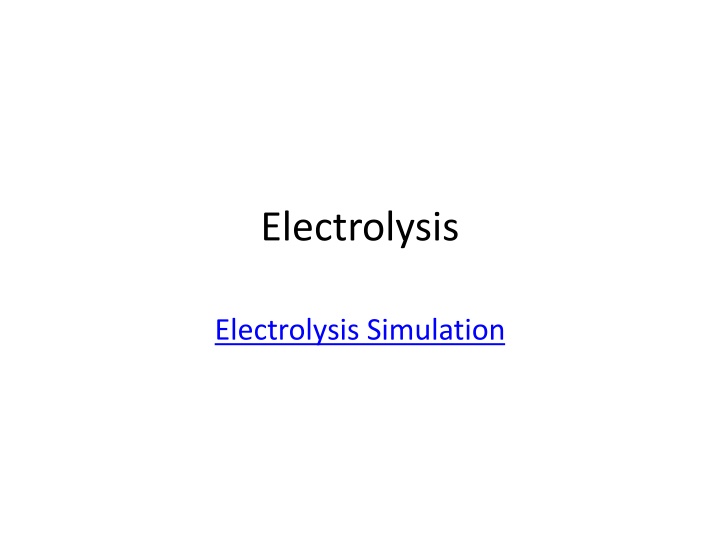
Electrolysis: Observations, Experiments, and Data Analysis
Explore the process of electrolysis through observations, experiments, and data analysis. Learn about the changes in metal amounts, flow of electrons, and mechanisms involved in electrode plating. Discover the relationship between current, time, and metal deposition.
Download Presentation

Please find below an Image/Link to download the presentation.
The content on the website is provided AS IS for your information and personal use only. It may not be sold, licensed, or shared on other websites without obtaining consent from the author. If you encounter any issues during the download, it is possible that the publisher has removed the file from their server.
You are allowed to download the files provided on this website for personal or commercial use, subject to the condition that they are used lawfully. All files are the property of their respective owners.
The content on the website is provided AS IS for your information and personal use only. It may not be sold, licensed, or shared on other websites without obtaining consent from the author.
E N D
Presentation Transcript
Electrolysis Electrolysis Simulation
Observations from the BCE 6.3 Describe the change in amount of metal on each electrode. How are these changes related? What flows from the + electrode in the external circuit via the wire? What causes the direction of the flow? What flows from the + electrode in the solution? What is the mechanism/process that transfers the amount of metal from one electrode to the other? Describe the action that causes the metal ions to plate on to the electrode. Write a chemical equation that summarizes your explanation. Describe the action that causes the metal ions to plate on to the + electrode. Write a chemical equation that summarizes your explanation.
Summarize the BCE Experiments What metals were used in the experiment you set up in the BCE? What variables effect the change in the amount of metal plated on the negative electrode? How did these variables effect the change?
Data From BCE 6.3 Current (amps) 3 amp 3 amp 2 amp Time (sec) Ag (107.87 g mol-1) Zn (65.38 g mol-1) Fe (55.85 g mol-1) 0.60 g 0.31 g 0.41 g 600 300 600 0.52 g 0.26 g 0.35 g 2.01g 1.00 g 1.34 g How does the amount in grams of the metal depend on current and time?
Proportionalities Time vs. Amount: Current vs. Amount:
Amount Observe the particulate level representation at the cathode and the anode for the silver/silver and the iron/iron system. Electrolysis Simulation How are the animations the same and different?
Data From BCE 6.3 Current (amps) 3 amp 3 amp 2 amp Time (sec) Fe (55.85 g mol- 1) 0.00931 mol 0.00466 mol 0.00627 mol Ag (107.87 g mol- 1) 0.0186 mol 0.00927 mol 0.0124 mol Zn (65.38 g mol-1) 0.00933 mol 0.00459 mol 0.00627 mol 600 300 600
Proportionalities What is the new proportionality equation that represents the relationships between amount, the number of electrons transferred, time and current?
Proportionalities amount (current * time)/charge To make this an equality find the value of the proportionality constant?
Proportionalities Time vs. Amount (moles): time moles Current vs. Amount (moles) : current(amps) moles Charge vs. Amount (moles) : 1/charge(n electrons/ion) moles
Summary Page Write the summary mathematical equation a couple of different ways. Moles = amps*seconds/(96,500 amp-sec/mol e-)*the number of e- transferred
Clicker Questions CQ1 CQ2
Application/Clicker Question What current (in units of amps) is required to plate out 1.22 g of nickel from a solution of Ni2+ in 1.00 hour? A) 65.4 B) 4.01 x 103 C) 1.11 D) 12.0 E) 2.34
Clicker Question How many minutes will it take to plate out 2.19 g of chromium metal from a solution of Cr3+ using a current of 35.2 amps in an electrolyte cell? A) 1.92 x 103 B) 5.77 C) 17.3 D) 115 E) 346
Variables Fe (55.85) Zn (65.37) Ag (107.87) 3 amp/10 min 0.00931 mol 0.00933 mol 0.0186 mol 3 amp/5 min 0.00466 mol 0.00459 mol 0.00927 mol 2 amp/10 min 0.00627 mol 0.00627 mol 0.0124 mol Fe (55.85) Zn (65.37) Ag (107.87) 3 amp/10 min 1 2 3 3 amp/5 min 4 5 6 2 amp/10 min 7 8 9 Time 1 vs 4 2 vs 5 3 vs 6 Current 1 vs 7 2 vs 8 3 vs 9 Amount 1 vs 2 4 vs 5 7 vs 8 Charge 1/2 vs 3 4/5 vs 6 7/8 vs 9
Proportionalities Time vs. Amount: amount(mols) time(sec) Current vs. Amount: amount(mols) current(amps) Current vs. Charge: amount(mols) 1/charge(n electrons/ion) mols = C x amp x sec/n, C = mols n/amp-sec
